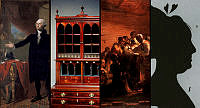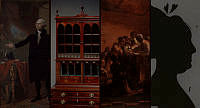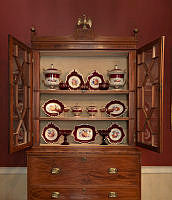Secretary-Bookcase, Lee House
This photograph is of the secretary-bookcase in the Truman Study in Lee House, one of four buildings that constitute the President's Guest House. The late 18th century secretary-bookcase is displaying the Blair family English (Worcester) Chamberlain porcelain dessert set, likely made between 1847 and 1850. The set is decorated with floral motifs, gilt, and a maroon banding.
Located on Pennsylvania Avenue, just across the street from the North Grounds of the White House, Lee House was built in 1859 by Francis Preston Blair for his daughter Elizabeth and her husband, Admiral Samuel Phillips Lee. Blair built the house next door to his residence, the more prominent and recognizable Blair House. President Harry S. Truman used this room as a home office and study while the Truman family resided in Blair House during the 1948-1952 White House renovation.


